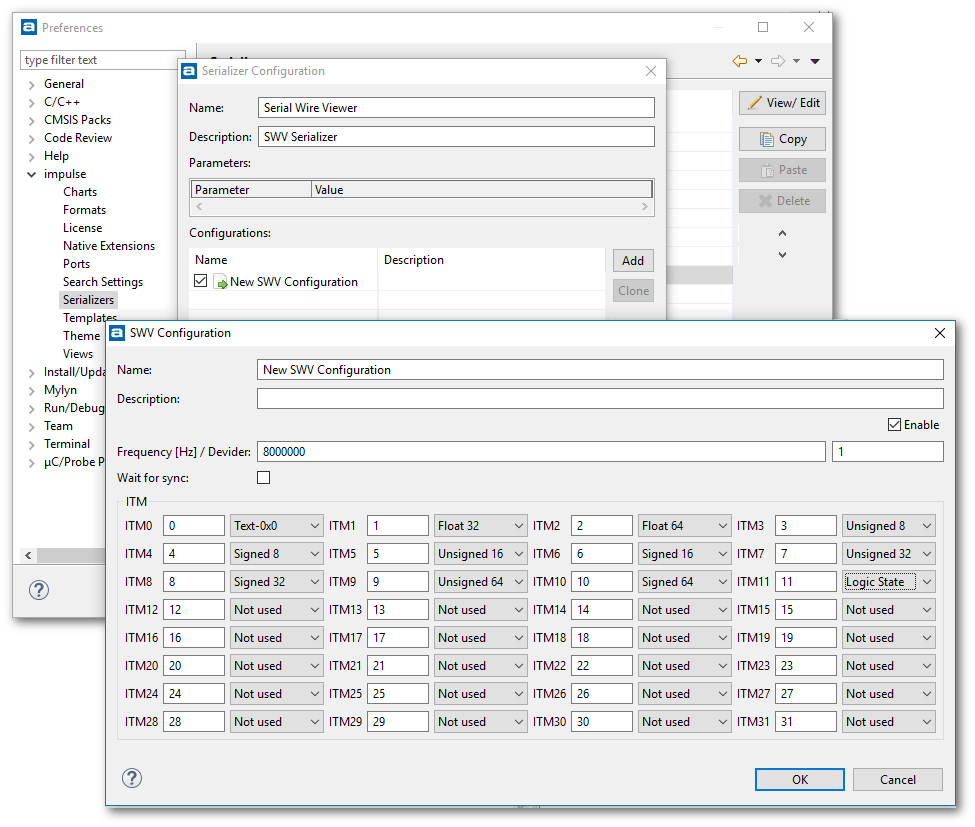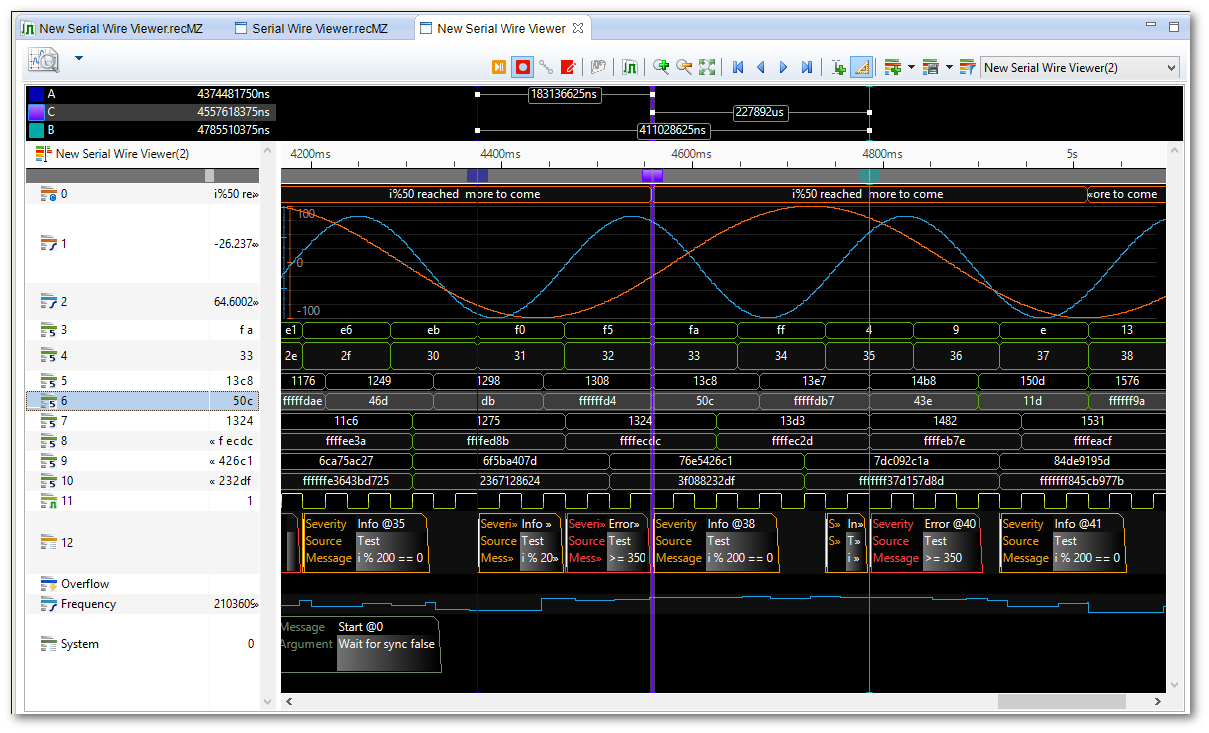RE02 SWV Reader
Outline
The Serial Wire Viewer from ARM (Cortex-M microcontroller) provides non-intrusive real-time tracing (ITM). This mechanism is usually used for printfs only. The impulse SWV reader enhances SWV use cases as it allows users to log and trace different kinds of data (real, integer, strings or logic), which can then be stored, visualized and analysed with impulse.
| Platforms: |
|
|||
| Requirements: |
|
|||
| Known limitations: |
|
|||
| Status: |
|
|||
| Operations: |
|
|||
| Parameters: |
|
|||
| Configuration: |
|
Video
Usage
The reader can be used to open workspace resources and together with ports (direct connection to the target using TCP, Serial, J-Link, ...).
Configuration
You can modify the serializer behavior under Preferences->impuse->Serializer->SWV Reader:
The SWV reader requires a serializer configuration to work. Get to Preferences>impuse->Serializer->Serial Wire Viewer, press Add and select the SWV configuration:
- Frequency/Divider: Enter the SWV frequency and divider value of your target.
- Wait for sync: If checked, the read will wait for a sync packet to continue.
- ITM0..31: Enter the data type for each ITM channel or "Not used".
Prepare the target
To import the Simple SWV Trace library and demo code, go to Import->impulse->Import Simple SWV Trace, select a root folder and press ok.Enable SWV
You may use the information of your board provider and the sample in demo.c to enable SWV tracing in your target:
void initSwv() {
DBGMCUCR |= 0x00000027;
DEMCR |= (1 << 24);
ITM_LSR = 0xC5ACCE55;
TPIU_SPPR = 0x00000002; // Select NRZ mode
TPIU_ACPR = 1; // Divider 1 means /2
ITM_TPR = 0x00000000;
DWT_CTRL = 0x400003FE;
FFCR = 0x00000100;
ITM_TCR = 0x1000F; // Enable ITM
ITM_ENA = 0xffff; // Enable ITM stimulus port
}
Use the Simple SWV Trace library
void itm_write_i8(unsigned char port, signed char b); void itm_write_i16(unsigned char port, short b); void itm_write_i32(unsigned char port, long b); void itm_write_i64(unsigned char port, long long b); void itm_write_f32(unsigned char port, float f); void itm_write_f64(unsigned char port, double f); void itm_write_t0(unsigned char port, const char* text); void itm_write_tn(unsigned char port, const char* text, char e); void itm_write_log(unsigned char port, unsigned char severity, const char* source, const char* message);The library convert several data types into a defined byte order. See the demo code in demo.c how to use.
Example
void demo() {
itm_write_t0(0, "Start Demo");
wait(100);
itm_write_t0(0, "Measure");
int i = 0;
float f = 0.0;
double d = 0.0;
unsigned char uc = 0;
signed char sc = 0;
unsigned short us = 0;
signed short ss = 0;
unsigned long ul = 0;
signed long sl = 0;
unsigned long long ull = 0;
signed long long sll = 0;
unsigned char logic = 0;
while (1) {
// float
f = sin(i / 100.0) * 100.;
d = cos(i / 50.0 + 1.0) * 50. + 20;
itm_write_f32(1, f);
itm_write_f64(2, d);
wait(10);
// text
if (i % 500 == 0)
itm_write_t0(0, "i%50 reached \nmore to come\n");
// bytes
if (i % 100 == 0) {
uc = i / 20;
sc += 1;
itm_write_i8(3, uc);
itm_write_i8(4, sc);
}
// short
if (i % 125 == 0) {
us = d + i;
ss = d * 20;
itm_write_i16(5, us);
itm_write_i16(6, ss);
}
// long
if (i % 175 == 0) {
ul = i;
sl = -i;
itm_write_i32(7, ul);
itm_write_i32(8, sl);
}
// long long
if (i % 225 == 0) {
ull += rand();
sll = (((long long) d) << 32) + rand();
itm_write_i64(9, ull);
itm_write_i64(10, sll);
}
// logic
if (i % 25 == 0) {
logic = i & 1;
itm_write_i8(11, logic);
}
// log
if (i > 0 && i % 200 == 0)
itm_write_log(12, SEVERITY_INFO, "Test", "i % 200 == 0");
if (i > 0 && i % 350 == 0)
itm_write_log(12, SEVERITY_ERROR, "Test", ">= 350");
i++;
}
}
Parse errors
The reader will provide a parse error message if the input can not be read. The message usually contains the error position, the reason for the failure and a stack trace.
If you can not resolve the problem (e.g. obvious format error in the input file), please send this message together with the input file to "This email address is being protected from spambots. You need JavaScript enabled to view it.".
Reader: de.toem.impulse.serializer.xyz Error at position: 4800 Text at position: "o !. Up Uq Ur" Message: Invalid character Type: class de.toem.impulse.serializer.ParseException Stack trace: de.toem.impulse.serializer.xyz.xyzReader.parse(XYZReader.java:459) de.toem.impulse.serializer.xyz.xyzReader.parse(xyzReader.java:363) de.toem.impulse.serializer.xyz.xyzReader.read(xyzReader.java:269) de.toem.impulse.serializer.xyz.xyzReader.read(xyzReader.java:237) de.toem.pattern.element.Element$1.execute(Element.java:1063) de.toem.eclipse.hooks.actives.EclipseActives$3.run(EclipseActives.java:73)
 32/64bit
32/64bit 32/64bit
32/64bit 32/64bit
32/64bit


